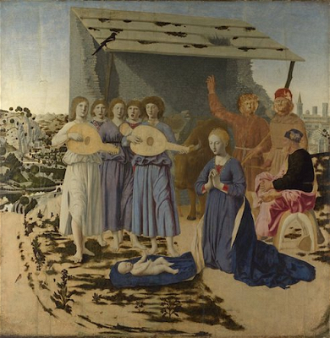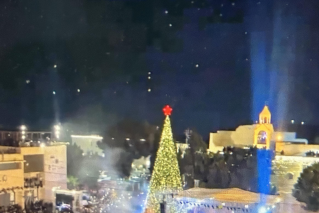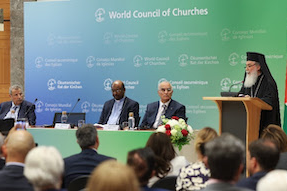Piero's mystical Nativity restored at National Gallery

The Nativity by Piero della Francesca at the National Gallery, Trafalgar Square
Renaissance masterpiece 'The Nativity' by Piero della Francesca, is back on view at the National Gallery, Trafalgar Square, in time for Christmas, following three years of restoration
Born in Borgo Sansepolcro, in Tuscany, Piero worked in various central Italian towns. Little is known of his life and many works are lost. It is known that he was working in Florence in 1439 with Veneziano, whose style influenced him. The Nativity is one of Piero's last works, and was made for his family palace in Borgo San Sepolcro, Tuscany. The painting remained with Piero's family until it came to London in the 1860s.
When the National Gallery acquired the painting in 1874, misunderstandings about its condition meant that, for a long time, it was thought to be unfinished. Questions were asked in Parliament concerning how much original paint had survived. Hansard records the lengthy defence of the expensive purchase by the Prime Minister, Benjamin Disraeli, concluding, "I congratulate the country on having acquired…a picture of the most rare and interesting character, and which I think, will add to the beauty and value of the National Collection."
Now, following conservation treatment of the damaged areas, the painting has returned to the Gallery walls in all its glory, displayed alone in Room 17a.
Senior Restorer Jill Dunkerton, under the direction of Conservator Britta New, carried out the work. A video on the Gallery's web site sees Jill enthusiastically explaining her challenging task.
Much of Piero's original scenario is now revealed. There is an overall sense of space and peace, and a shaft of heavenly light falling on the shed's stone wall through a hole in its roof, resembling a theatrical spotlight illuminating the scene from the rear, is key. This makes the figures recede as they should, allowing us to appreciate again Piero's mastery of light, colour and space. Retouching of abraded paint on the stable has made visible a patch of light stones and the younger shepherd's hand is revealed as pointing to the light coming through the roof. The Gallery is excited that this is now manifest for the first time in centuries.
Piero sets the Nativity in a tranquil Tuscan landscape recalling the surroundings of his hometown. Mary kneels before the new born Christ, her ultramarine cloak spread to protect him from the bare earth. Behind her are two shepherds, while Joseph, is seated on a donkey's saddle. A group of angels, singing and playing lutes, provide a heavenly accompaniment to this rustic scene. The stable is a ramshackle and ruined brick lean-to on top of an exposed rocky outcrop, typical of those still seen in Italy today.
Piero presents The Nativity as inspired by the miraculous vision of St Bridget of Sweden on a pilgrimage to Bethlehem in 1372. The 14th-century mystic's visions are mostly of Christ's Passion. She also reflected on aspects of Mary's life, in particular her Immaculate Conception, living in Nazareth and sufferings at the foot of the cross as 'Mother and Teacher of all'.
"When I gazed upon and contemplated his beauty, joy seeped through my soul like dewdrops and I knew myself to be unworthy of such a son. But when I considered the places where (as I had learned from the predictions of the prophets) nails would be pierced through his hands and feet at the crucifixion, my eyes filled with tears and my heart was almost torn apart by sorrow....... So my joy was always mixed with sorrow." Symbols of that sorrow indicated in the painting include goldfinches representative of the Passion to the left of the painting, a magpie perched on the stable roof and pearls trimming the bodice of Marys' dress.
Previously framed and displayed as an altarpiece in the Gallery's collection, the work is now understood to be instead a very grand, domestic painting probably painted by Piero for his family palazzo. A carved walnut frame, of almost exactly the same dimensions, date and probable origin has been acquired and perfectly enhances the restored masterpiece.
Dr Gabriele Finaldi, Director of the National Gallery, says: "Piero's Nativity is a beautiful and profound meditation on the Christmas story. The recent conservation project has enabled us to see just how carefully planned every element of the picture is, from the play of light across surfaces to the rendition of the distant San Sepolcro hills. Over five centuries after Piero's lifetime, we can still marvel at his artistic vision, his skill and his sheer inventiveness."
For more information and tickets for online events, see: www.nationalgallery.org.uk


















